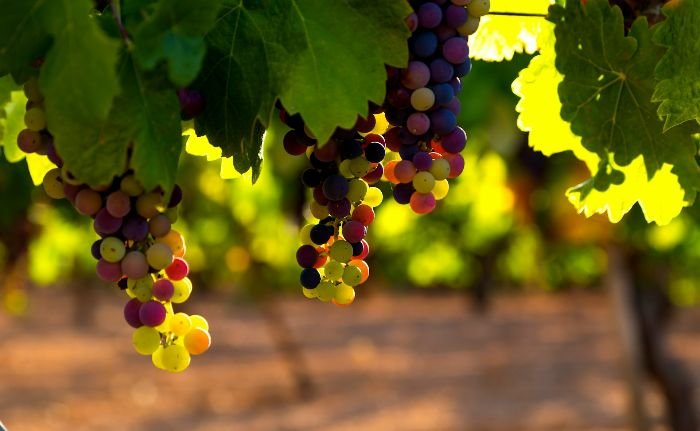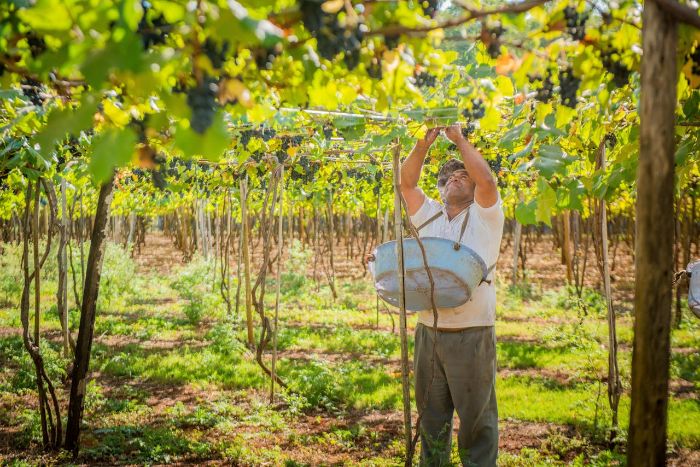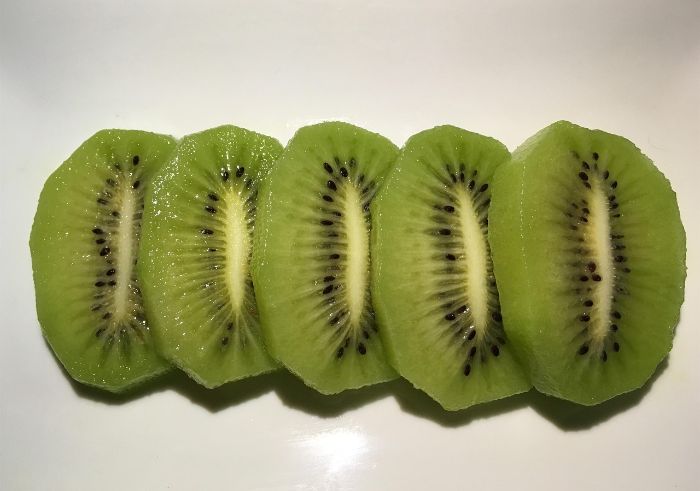Have you ever dreamed of having your vineyard? Imagine being able to grow grapevines and make your wine. But where to start? And how do you make sure it will work? This guide will give you tips and insights to begin your vineyard adventure with confidence.
This guide is for wine lovers wanting to make their own wine or those attracted to growing grapes. We will talk about choosing the best grapes and the key steps to start your vineyard. Everything essential for getting you started is here.
Key Takeaways:
- Starting your own vineyard can be a rewarding and fulfilling endeavor.
- Properly selecting grape varieties is crucial for the success of your vineyard.
- Understanding the steps involved in vineyard establishment is essential.
- Care and maintenance play a significant role in the health and productivity of grape vines.
- Harvesting grapes at the right time is crucial for achieving desired flavor and quality.
Table of Contents
Introduction to Starting a Vineyard
Let’s look at why starting a vineyard is so appealing to many. We will talk about how fun it is to grow grapes. You can make your own wine. It helps you connect with nature too. We will also cover the main steps to make your vineyard dream real.
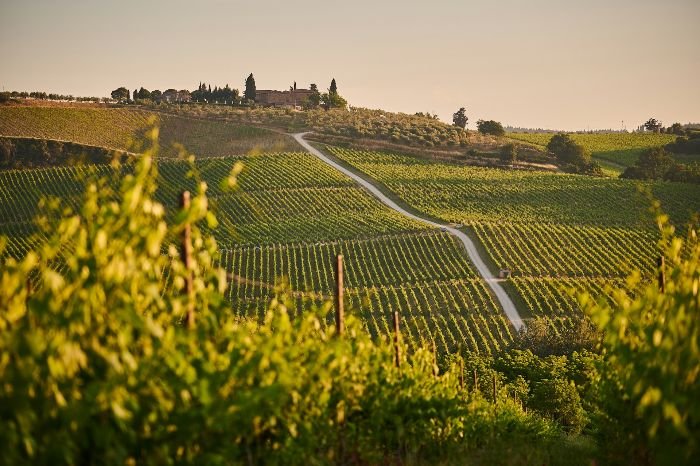
The Appeal of Growing Your Own Grapes
Growing grapes from start to finish has a special charm. You see the beauty and detail of nature. Each vine is a unique story. It reflects the land it grows on and the care put into it. Making wine from your own grapes lets you create something that suits your taste. It’s a rewarding and personal journey.
Overview of Vineyard Establishment
Starting a vineyard is all about careful planning and doing things right. It involves choosing the best grape types and getting the soil ready. Also, you need to set up a way for the vines to grow. Every step is key to a successful vineyard. The process includes picking a site, getting the soil ready, planting the grapes, putting up the support for the vines, caring for them, and finally enjoying your own grape harvest. This introduction will help you understand what it takes. It prepares you to make smart choices and succeed.
Choosing the Right Grape Varieties
Wine Grapes vs. Table Grapes
Deciding between wine grapes and table grapes is a big step in vineyard planning. Wine grapes are for making wine, and table grapes are for eating. Each type has unique flavors and uses.
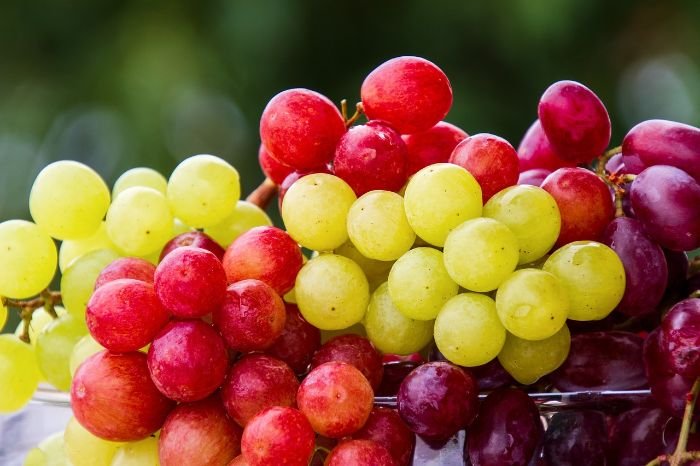
Wine grapes are small, have thick skins, and lots of sugar. They’re perfect for wine. Varietals like Cabernet Sauvignon, Chardonnay, and Pinot Noir offer different tastes.
Table grapes are larger, juicy, and sweet. People love them as a quick snack or in recipes. Thompson Seedless, Flame Seedless, and Concord are popular for eating.
Popular Varieties for Beginners
Starting with easy-to-grow grapes is wise for beginners. These grapes fight off disease well and grow without much trouble. Here are some recommended types:
- Concord – Known for its tough skin and disease resistance. It has small to medium clusters of sweet, blue-black berries.
- Marselan – A newer grape, a mix of Cabernet Sauvignon and Grenache. It’s resistant to diseases and bears tasty dark berries in moderate clusters.
- Green Thompson Seedless – A favorite white grape that’s seedless and crunchy. It forms big clusters of sweet, green grapes.
Factors to Consider in Variety Selection
Choosing the right grape variety depends on a few key factors. Let’s look at what matters most:
- Climatic conditions – Grapes vary in their needs for heat and water. Pick grapes that fit the weather of your vineyard.
- Vineyard location – Different grapes prefer different soils and elevations. Match the grape with your land’s specifics for the best results.
- Desired wine style – Think about the wine you want to make. Grape types affect taste and style. Choose grapes that will make the wine you like.
Thinking about these things helps you choose the best grapes for your vineyard. This can lead to a healthy harvest and great-tasting grapes.
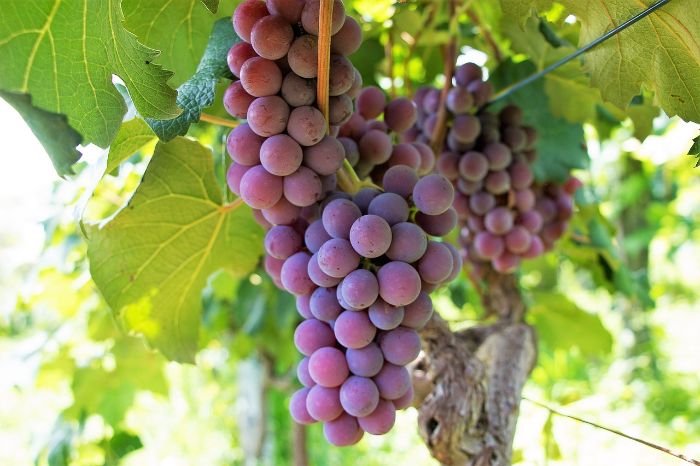
Site Selection and Preparation
Choosing the best spot for your vineyard is key to its success. It’s important to pick a place where grapes can grow well. Good soil and the right layout make a vineyard healthy and productive.
Ideal Climate and Soil Conditions
Grapes do best in areas with the right climate. They like places with not too cold winters and enough sunlight. The soil should be well-drained but not too dry.
It’s vital to test the soil before planting. This helps you know if it has the right nutrients for grapes. A good soil test shows if the soil needs any changes before planting.
Preparing the Soil for Planting
Starting with clean soil is important. Remove any weeds and debris. Then, test the soil to see if you need to adjust it for planting.
Adding compost or manure can make the soil better for growing. Mix these in the soil well. Use the right nutrients based on your soil test.
Layout and Spacing for Vines
How you set up and space your vines matters a lot. It helps the vines get enough air and light. And makes it easier to care for them.
Leaving 6-10 feet between rows is good for airflow and sunlight. Space vines the same distance in a row. This helps the vines get what they need and stay healthy.
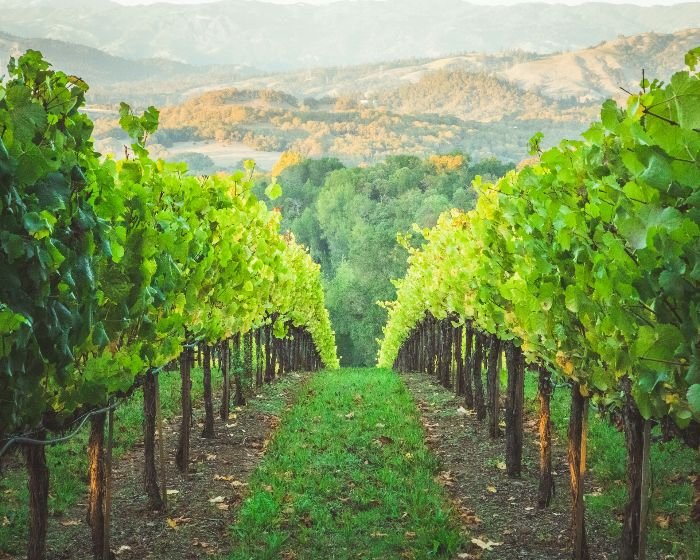
Creating a balanced vineyard design is important. Think about the space, the shape, and how you’ll take care of your vines. Good planning makes a big difference in your vineyard’s success.
Note: Picking the right spot, testing and prepping the soil, and laying out your vineyard well are key steps. They help your grapevines grow strong and give you great grapes.
Planting Your Grapes
After picking your grape types and setting up the area, it’s planting time. Use these steps to make sure your grape vines start well:
Selecting Healthy Vines or Cuttings
It is very important to choose vines or cuttings that are healthy and without disease. Look for ones with strong buds and avoid any that look bad. Check the roots for rot. With healthy starts, your grape vines will have a better chance to grow well.
Step-by-Step Planting Guide
- Prepare the planting hole – Dig a hole that’s big enough for the vine’s roots. Make sure it’s at least twice the size of the root ball.
- Amend the soil – Mix in organic material like compost to make the soil better for the vines. This helps the vines to get the nutrients they need.
- Place the vine in the hole – Put the vine or cutting in the hole, spreading out the roots. Make sure the soil covers them but not the graft union.
- Backfill the hole – Fill the hole with soil and press gently around the roots. The vine’s base should be level with the ground.
- Water thoroughly – Water the vine well after you plant it. This helps the soil settle and the roots to get hydrated.
- Add mulch – Put mulch around the base of the vine to keep in moisture, stop weeds, and keep the soil at the right temperature.
Initial Care and Watering
Just planted grape vines need a lot of care in the beginning. Here’s what you need to do:
- Watering – Water the vines a lot in the first year to help them grow strong roots.
- Monitoring soil moisture – Check the soil’s wetness often and water as needed. Remember, grape vines like soil that drains well.
- Pruning – Trim the new vines to help them grow better. Get advice from grape growers on the right way to prune.
- Weed control – Keep the area around the vines free of weeds. This stops them from taking nutrients away from your vines.
By following these steps, you’ll help your grape vines get off to a great start and be healthy in your vineyard.
Establishing a Trellis System
A trellis system is very important for grape vines. It helps in their growth and keeps them neat. It makes sure vines and fruits are stable and gets enough sunlight. Without a trellis, vines could get tangled and not ripen well. So, setting up a trellis is key when starting a vineyard.
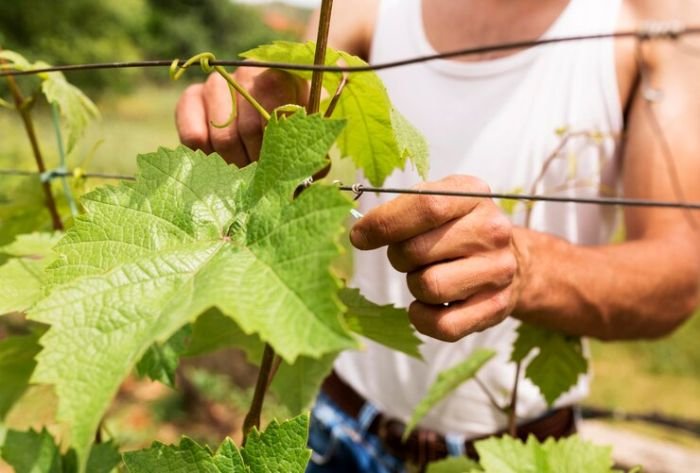
Importance of Support Structures
Support from the trellis helps grape vines grow the right way. They need something to hold on to as they get bigger. The trellis keeps them off the ground and helps them grow up. This setup also makes sure the vines and fruits don’t break. Plus, it stops diseases by letting air flow through.
Types of Trellis Systems
Vineyards use many trellis types, each with unique benefits. Some options are:
- Vertical Shoot Positioning (VSP) – Here, grapevines grow up tall along wires. They get lots of sun and air, making grapes better and diseases fewer.
- High-wire – Raises vines off the ground, with more air around them. It makes vineyards easier to look after.
- Pergola – For looks, it forms a shady spot with vines overhead, making a nice space.
Installation Tips for Beginners
Starting the trellis might look hard at first. But, the right advice can make it easy. Here’s how:
- Plan ahead – Think about where to put the posts and wires for the vines to have space and support.
- Choose the right materials – Go for strong stuff like stainless steel and treated wood that lasts and supports well.
- Proper anchoring – Make sure the trellis doesn’t move. Deep holes and concrete help keep it steady.
- Train the vines – Help the vines find the trellis using ties. Check and fix their places now and then.
- Maintenance and repairs – Keep an eye on the trellis for damages. Fix or change what’s broken to keep it working.
Using these tips, you can make a good trellis. It will help your grape vines grow well. This is how you start a successful vineyard.
Care and Maintenance of Vines
Caring for grape vines is vital for their health and fruit. We’ll share tips to help your vines grow well and produce a lot of grapes.
Pruning Techniques for Healthy Growth
Pruning is key for vine health. It involves cutting away old wood and extra leaves. This makes the grapes better. Pruning methods differ for various grapes and places. It’s best to prune when the ground is cold, to protect the vine.
Watering and Fertilizing Strategies
Good watering and feeding keep your grape vines strong. Give them enough water, especially when it’s dry. Water deeply but not too often to help their roots reach deep. Adding a layer of mulch can also keep the soil moist and the weeds away.
Fertilizer gives vines the nutrients they need to grow and bear fruit. Test the soil to see what your vines specifically need. This way, you can give them the right food.
Pest and Disease Management
Keeping pests and diseases at bay is critical. Use methods that reduce chemical use but still protect the vines. Watching the vines closely helps catch problems early. This lets you deal with them before they spread.
Grapes can suffer from bugs and diseases like mildew and rot. Good vineyard practices, like enough space between vines and air flow, can stop many issues.
With the right care, your vineyard will thrive. Good care means better grapes, and better grapes make fine wine. So, look after your vines well.
Harvesting Grapes
Getting grapes at the right time is key for good wine or tasty table grapes. We will talk about what makes the best time to pick grapes. This includes looking at the sugar and acidity in the grapes, their flavor, and what kind of wine you want to make.
Determining the Right Time to Harvest
Deciding when to pick grapes is a big deal. Grape sugar and acidity matter a lot. They need the right sugar to be sweet and enough acidity for freshness. Testing often is important to pick the best time.
Grapes get tastier as they mature. Their flavors change and make the wine better. Look at how they smell, taste, and change in looks to know when they’re just right.
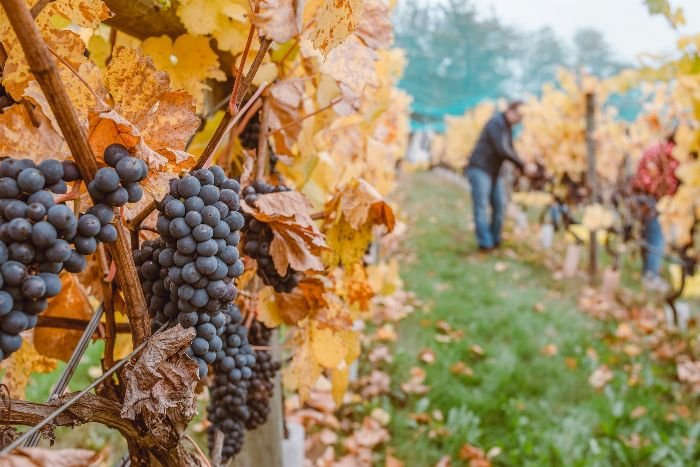
The type of wine you want also decides when to pick. Picking early makes wine with more freshness. Waiting gives you wine with richer fruit flavors. Your choice makes a big difference.
Harvesting Techniques for Wine and Table Grapes
How you harvest grapes depends on what they’re for.
For wine, picking by hand is best. It lets you choose only the best bunches. This makes sure your wine grapes are top quality. It also keeps them from getting hurt.
For eating, you can pick grapes by hand or machine. Big farms usually use machines. These shake the grapes off into bins. But for small farms or unique grapes, handpicking keeps them looking good.
Post-Harvest Handling and Storage
After picking, keeping grapes fresh is a must.
Cooling them fast is very important for wine grapes. It keeps their special smells and tastes. How you store them affects how long they keep. Cool and humid places slow down how fast the grapes change.
Handle them with care to avoid hurting them. Pick out any bad grapes to keep the others fresh. This lowers the chance of harm or bad taste.
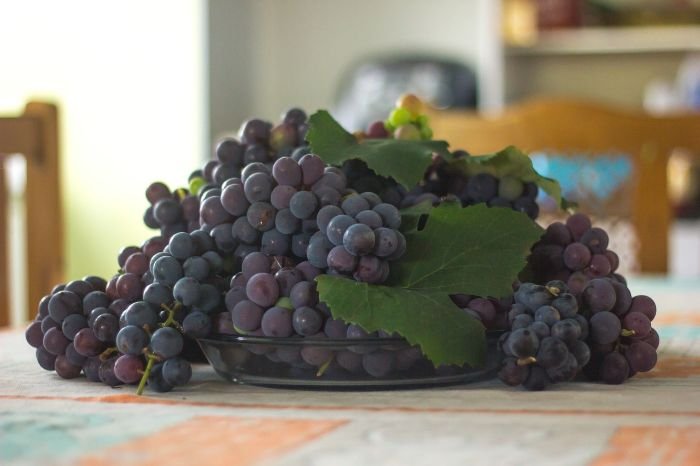
Doing all of this means your grapes stay fresh and taste great. No matter if you’re making wine or eating them, good care makes a big difference.
Tips for Successful Grape Growing
To grow grapes successfully, it’s vital to follow key tips. Watching your vines’ health and dealing with problems early is essential. Also, following seasonal care routines is crucial for a great grape crop.
Monitoring Vine Health and Growth
Watching your grape vines often is key. Look for signs of health like leaf color and stem appearance. If you see any unusual changes, it’s important to check them out. This stops bigger issues before they start.
Dealing with Common Issues
Growing grapes has its challenges like nutrient lacks, diseases, and pests. Knowing about these issues and their warning signs is crucial. This helps you catch and handle them early. Using the right pest and disease management methods is important to keep your vines safe and healthy.
Seasonal Care Routines
Grape vines need care at all growing stages. This ranges from pruning when they’re dormant to managing water and nutrients well. Each season has its own tasks. Getting to know these tasks and making a care plan for your vines is key. It ensures they have what they need to grow well.
By using these grape growing tips, you can boost your vineyard’s health and yield. Watch your vines’ health, tackle issues early, and stick to a care plan. With the right care, your grape vines will do great. You’ll enjoy a big, healthy harvest.
Conclusion – Starting Your Vineyard Journey
Congratulations on starting your vineyard journey! This guide has shared valuable insights to help you begin. With knowledge and effort, you can grow grapes and enjoy a meaningful experience.
To start a vineyard, plan carefully. Choose the right grape types and prepare the soil. Every step is important for a successful vineyard. By using the advice in this guide, you’re on your way to a solid start.
Keep an eye on your vines’ health and growth. Deal with any problems and follow care routines for each season. This care will help your vineyard thrive and produce top grapes.
We hope this guide has given you the confidence to grow grapes successfully. Remember, growing grapes is a learning journey. With love for what you do and hard work, you’ll see wonderful results. Best of luck and may your vineyard bring in abundant harvests!
FAQ
Why should I start my own vineyard?
Starting your own vineyard is rewarding. You can grow your own grapes for wine. It’s a way to enjoy nature and the beauty of a vineyard.
What are the key steps involved in establishing a vineyard?
First, pick the right grape varieties and a good location. Then, prepare the soil and plant the grapes. After that, set up a trellis system and care for the vines regularly.
What are the differences between wine grapes and table grapes?
Wine grapes are for making wine, fresh to eat table grapes. Wine grapes are sweeter with less acid than table grapes. They also have thicker skins and smaller berries.
Which grape varieties are suitable for beginners?
For beginners, try Cabernet Sauvignon and Chardonnay. Also, Merlot, Pinot Noir, Riesling, and Sauvignon Blanc are good choices. They are hardy and adapt well to different climates.
What factors should I consider when choosing grape varieties?
Think about your region’s climate and your vineyard’s location. Also, consider the kind of wine you want to make. Choose grapes that match your climate and goals.
What are the ideal climate and soil conditions for growing grapes?
Grapes like a Mediterranean climate. They need well-drained, fertile soil. The soil’s pH should be between 5.5 and 7.0 with lots of organic matter.
How do I prepare the soil for planting grapes?
First, test your soil for nutrients and pH. Then, add organic materials or adjust the pH as needed. Good soil preparation is key for healthy vines.
Why is a trellis system important for grape vines?
A trellis supports grape vines as they grow. It helps with vine and fruit weight. Also, it makes pruning, training, and caring for vines easier.
What pruning techniques should I use for grape vines?
Use cane or spur pruning to keep vines healthy. Prune them while they are dormant. This helps control growth and lets sunlight into the vine canopy.
How do I know when to harvest my grapes?
The right time to harvest depends on sugar, acid levels, and flavor. For wine grapes, use tools like a refractometer for sugar and a pH meter for acid. Tasting them is also key.






